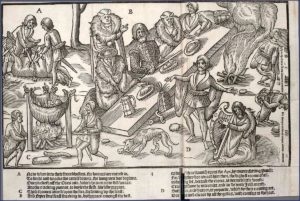On February 22nd Professor Cope gave a lecture about the spread of information in early modern Europe. This connected to class in many ways, one of which being that modern viewers have to learn to read the the information-packed woodcuts, similar to how we have worked to “read” Steve Prince’s woodcuts. Often in the woodcuts there is a circular flow of the eye. My favorite woodcut of all time is John Derrick’s “Image of Ireland.”

It is meant to show how the Irish people are savages with no understanding of proper manners, but it is so funny to a modern reader. These woodcuts were useful in the 1500’s because people had “different” literacy skills, ie analyzing pictures. I think in today’s world, since print is dead, the equivalent is video content, so I guess you could say that the need for different formats to spread information is a recursive trend.
From an ecological perspective, many of the concerns that Cope mentioned the English dealing with will increasingly come to affect us too. Displaced people will have to migrate to new places not destroyed by climate change, and so far we have made their existence without a home illegal, like under the Elizabethan laws. Personally what I found most interesting from this lecture was learning about morality before capitalism, where violating the sense of community would be punished in the moral economy. Communities like the ones Prince’s work nurtures used to play larger parts in everyone’s life, and I wonder if that will be part of the ecological solution.

